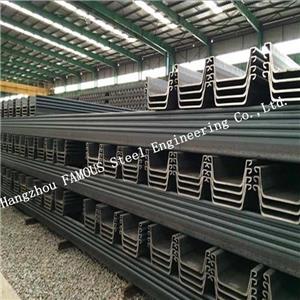| Message: | Product Details
Cold-formed steel sheet piles include non-bite-shaped cold-formed steel sheet piles (also known as trench plates) and bite-shaped cold-formed steel sheet piles (divided into L-shaped, S-shaped, U-shaped, and Z-shaped). Production process: Use thinner plate (common thickness 8mm ~ 14mm) in the cold bending machine continuous roll forming. Advantages: less investment in production line, lower production cost, flexible product size control. Disadvantages: the thickness of each part of the pile body is the same, the cross-sectional size cannot be optimized, resulting in increased steel consumption, the shape of the lock part is difficult to control, the joint is not tightly fastened, and the water cannot be stopped, and the pile body is prone to tear during use.
The cold-formed steel sheet pile is continuously rolled and formed by the cold-bending unit, and the side locks can be continuously overlapped to form a steel structure of sheet pile wall. Cold-formed steel sheet piles are made of thinner plates (commonly used with a thickness of 8mm to 14mm) and are processed by cold-formed forming units. The production cost is lower and the price is cheaper, and the fixed length control is more flexible. However, due to the rough processing method, the thickness of each part of the pile body is the same, and the cross-sectional size cannot be optimized, resulting in an increase in steel consumption; the shape of the lock part is difficult to control, the joint is not tightly fastened, and it cannot stop the water; It can produce low-strength steel grades and thinner products; and the stress generated during cold bending is relatively large, and the pile body is prone to tearing during use, and the application has large limitations. In engineering construction, the application range of cold-formed steel sheet piles is relatively narrow, and most of them are only used as supplementary materials for the application. The characteristics of cold-formed st......url:http://www.chinasteelengineering.com |
 my account
my account
 log out
log out
 my account
my account
 log out
log out
